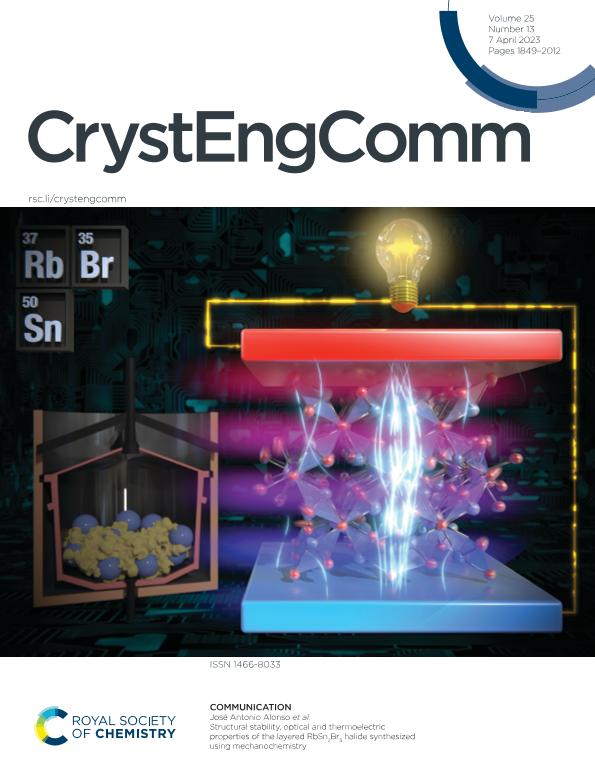Mostrar el registro sencillo del ítem
dc.contributor.author
Abia, Carmen
dc.contributor.author
Lopez, Carlos Alberto

dc.contributor.author
Gainza, Javier
dc.contributor.author
Rodrigues, João Elias F. S.
dc.contributor.author
Fragoso, Brenda
dc.contributor.author
Ferrer, Mateus M.
dc.contributor.author
Nemes, Norbert M.
dc.contributor.author
Dura, Oscar J.
dc.contributor.author
Martínez, José Luis
dc.contributor.author
Fernández Díaz, María Teresa
dc.contributor.author
Alonso, José Antonio

dc.date.available
2024-02-19T14:07:53Z
dc.date.issued
2023-02
dc.identifier.citation
Abia, Carmen; Lopez, Carlos Alberto; Gainza, Javier; Rodrigues, João Elias F. S.; Fragoso, Brenda; et al.; Structural stability, optical and thermoelectric properties of the layered RbSn2Br5 halide synthesized using mechanochemistry; Royal Society of Chemistry; CrystEngComm; 25; 13; 2-2023; 1857-1868
dc.identifier.issn
1466-8033
dc.identifier.uri
http://hdl.handle.net/11336/227420
dc.description.abstract
Two-dimensional (2D) layered metal halide perovskites have recently received a lot of attention due to their possible applications as photovoltaic and optoelectronic materials. Rubidium di-tin pentabromide, RbSn2Br5, is a promising lead-free alternative to its RbPb2Br5 counterpart. Its lack of toxic lead, improved stability, and tolerance to ambient conditions are a great step forward to be used in electronic devices. In contrast with lead-based halides, this sample has received less attention up to now. There have been no experimental studies on its transport parameters such as electronic conductivity, Seebeck coefficient, or thermal transport. Here, we describe how this material can be easily synthesized using a ball milling procedure, obtaining specimens with high crystallinity. TG measurements indicate total decomposition above ∼673 K, whereas DSC curves suggest melting and recrystallization at 562 K (heating run, endothermic) and 523 K (cooling run, exothermic), respectively. A structural analysis from room temperature up to 548 K from neutron powder diffraction (NPD) data allowed the determination of the Debye model parameters, providing information on the relative Rb-Br and Sn-Br chemical bonds. Synchrotron X-ray diffraction experiments confirmed a tetragonal structure (space group I4/mcm) and provided evidence on the presence of the Sn2+ lone electron pair (5s2) from a X-N study. Diffuse reflectance UV-vis spectroscopy yields an indirect optical gap of ∼3.08 eV, coincident with the literature and ab initio calculations. A maximum positive Seebeck coefficient of ∼2.3 × 104 μV K−1 is obtained at 440 K, which is one order of magnitude higher than those reported for other halide perovskites. We obtain an ultra-low thermal conductivity, below 0.2 W m−1 K−1 from 300 up to 550 K.
dc.format
application/pdf
dc.language.iso
eng
dc.publisher
Royal Society of Chemistry

dc.rights
info:eu-repo/semantics/openAccess
dc.rights.uri
https://creativecommons.org/licenses/by-nc/2.5/ar/
dc.subject
mechanochemistry
dc.subject
RbSn2Br5
dc.subject
optical
dc.subject.classification
Química Inorgánica y Nuclear

dc.subject.classification
Ciencias Químicas

dc.subject.classification
CIENCIAS NATURALES Y EXACTAS

dc.title
Structural stability, optical and thermoelectric properties of the layered RbSn2Br5 halide synthesized using mechanochemistry
dc.type
info:eu-repo/semantics/article
dc.type
info:ar-repo/semantics/artículo
dc.type
info:eu-repo/semantics/publishedVersion
dc.date.updated
2024-02-19T10:52:11Z
dc.journal.volume
25
dc.journal.number
13
dc.journal.pagination
1857-1868
dc.journal.pais
Reino Unido

dc.journal.ciudad
Cambridge
dc.description.fil
Fil: Abia, Carmen. Instituto de Ciencia de Materiales de Madrid; España. Institut Laue Langevin; Francia
dc.description.fil
Fil: Lopez, Carlos Alberto. Consejo Nacional de Investigaciones Científicas y Técnicas. Centro Científico Tecnológico Conicet - San Luis. Instituto de Investigaciones en Tecnología Química. Universidad Nacional de San Luis. Facultad de Química, Bioquímica y Farmacia. Instituto de Investigaciones en Tecnología Química; Argentina. Universidad Nacional de San Luis. Facultad de Química, Bioquímica y Farmacia. Área Química General e Inorgánica; Argentina. Instituto de Ciencia de Materiales de Madrid; España
dc.description.fil
Fil: Gainza, Javier. Instituto de Ciencia de Materiales de Madrid; España
dc.description.fil
Fil: Rodrigues, João Elias F. S.. European Synchrotron Radiation; Francia. Instituto de Ciencia de Materiales de Madrid; España
dc.description.fil
Fil: Fragoso, Brenda. Universidade Federal de Pelotas; Brasil
dc.description.fil
Fil: Ferrer, Mateus M.. Universidade Federal de Pelotas; Brasil
dc.description.fil
Fil: Nemes, Norbert M.. Universidad Complutense de Madrid; España. Instituto de Ciencia de Materiales de Madrid; España
dc.description.fil
Fil: Dura, Oscar J.. Universidad de Castilla-La Mancha; España
dc.description.fil
Fil: Martínez, José Luis. Instituto de Ciencia de Materiales de Madrid; España
dc.description.fil
Fil: Fernández Díaz, María Teresa. Institut Laue Langevin; Francia
dc.description.fil
Fil: Alonso, José Antonio. Instituto de Ciencia de Materiales de Madrid; España
dc.journal.title
CrystEngComm

dc.relation.alternativeid
info:eu-repo/semantics/altIdentifier/doi/http://dx.doi.org/10.1039/d2ce01488b
dc.relation.alternativeid
info:eu-repo/semantics/altIdentifier/url/https://pubs.rsc.org/en/content/articlelanding/2023/ce/d2ce01488b
Archivos asociados
